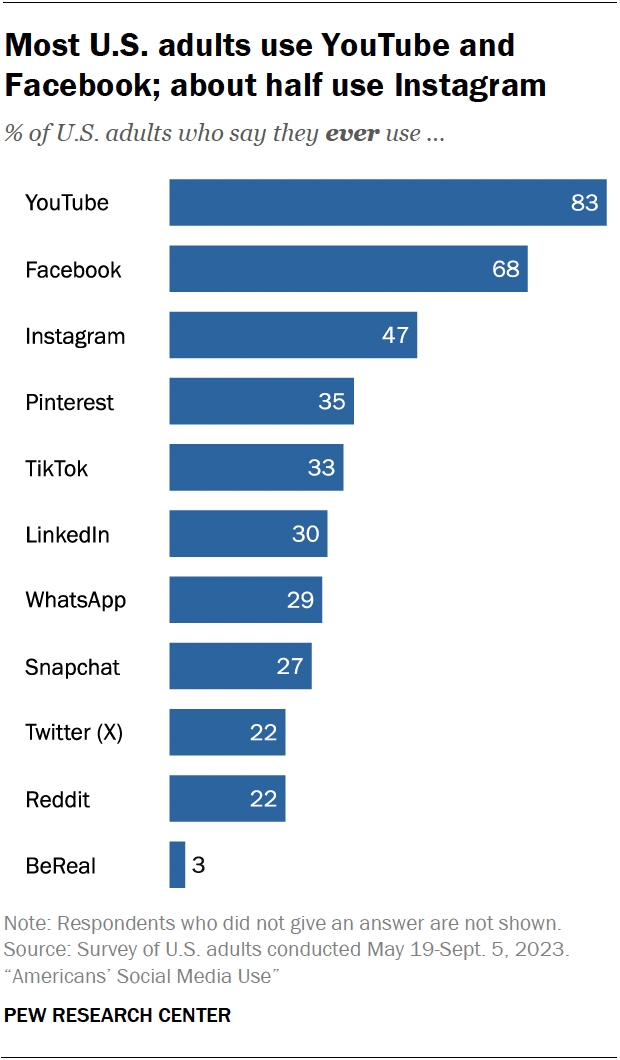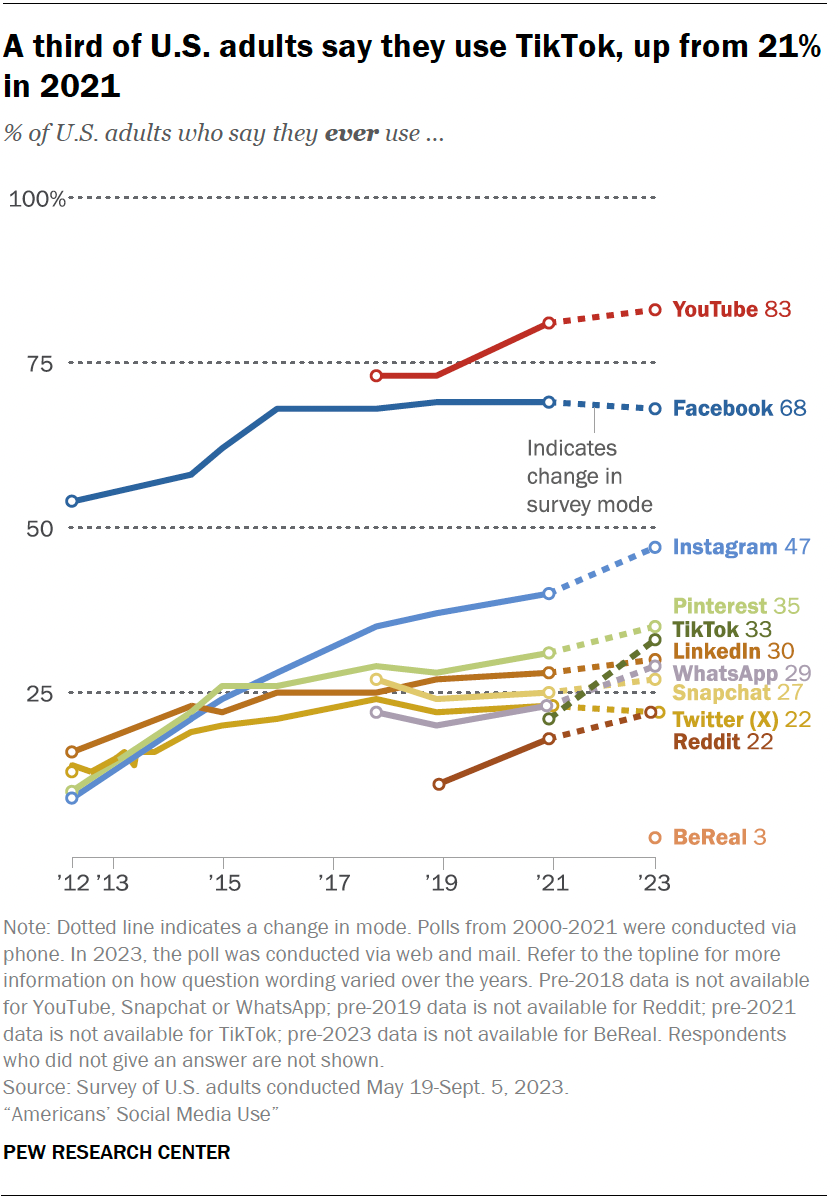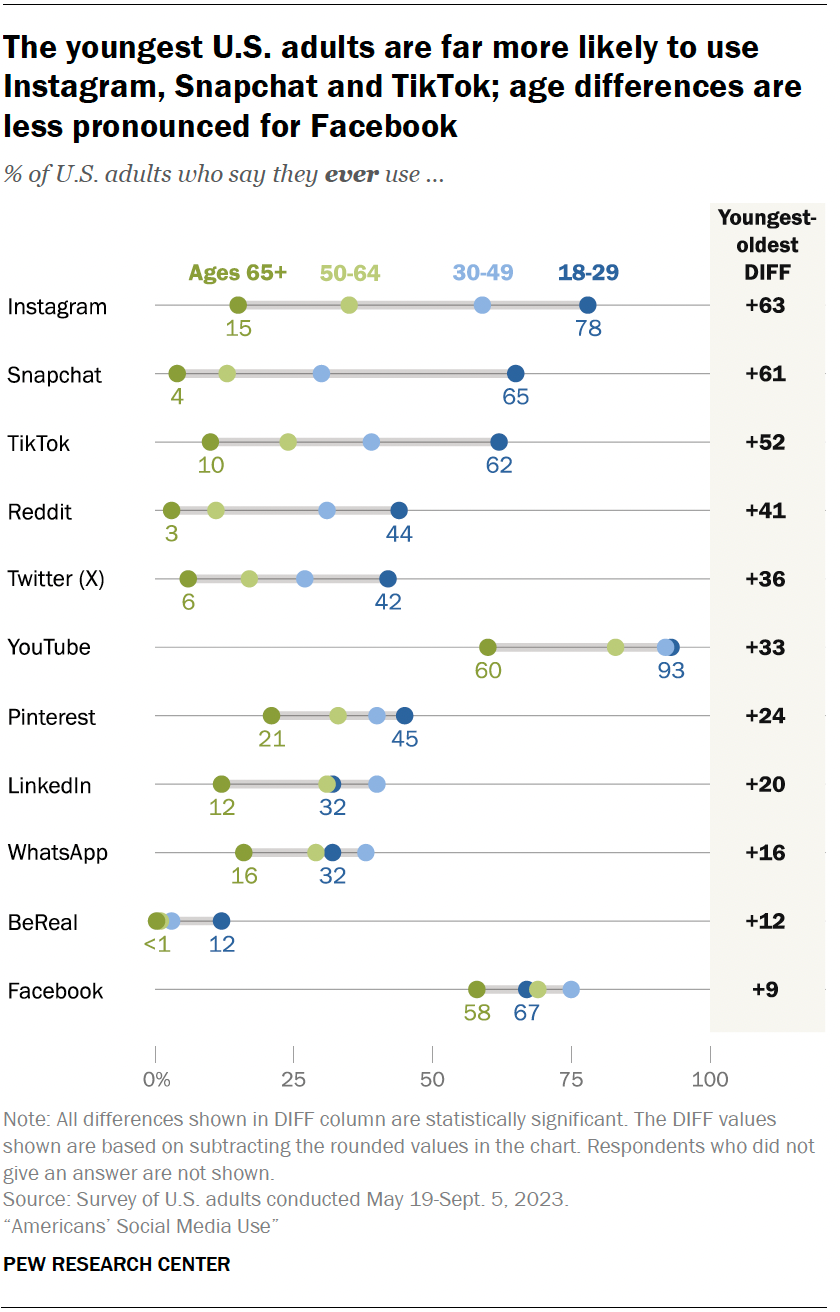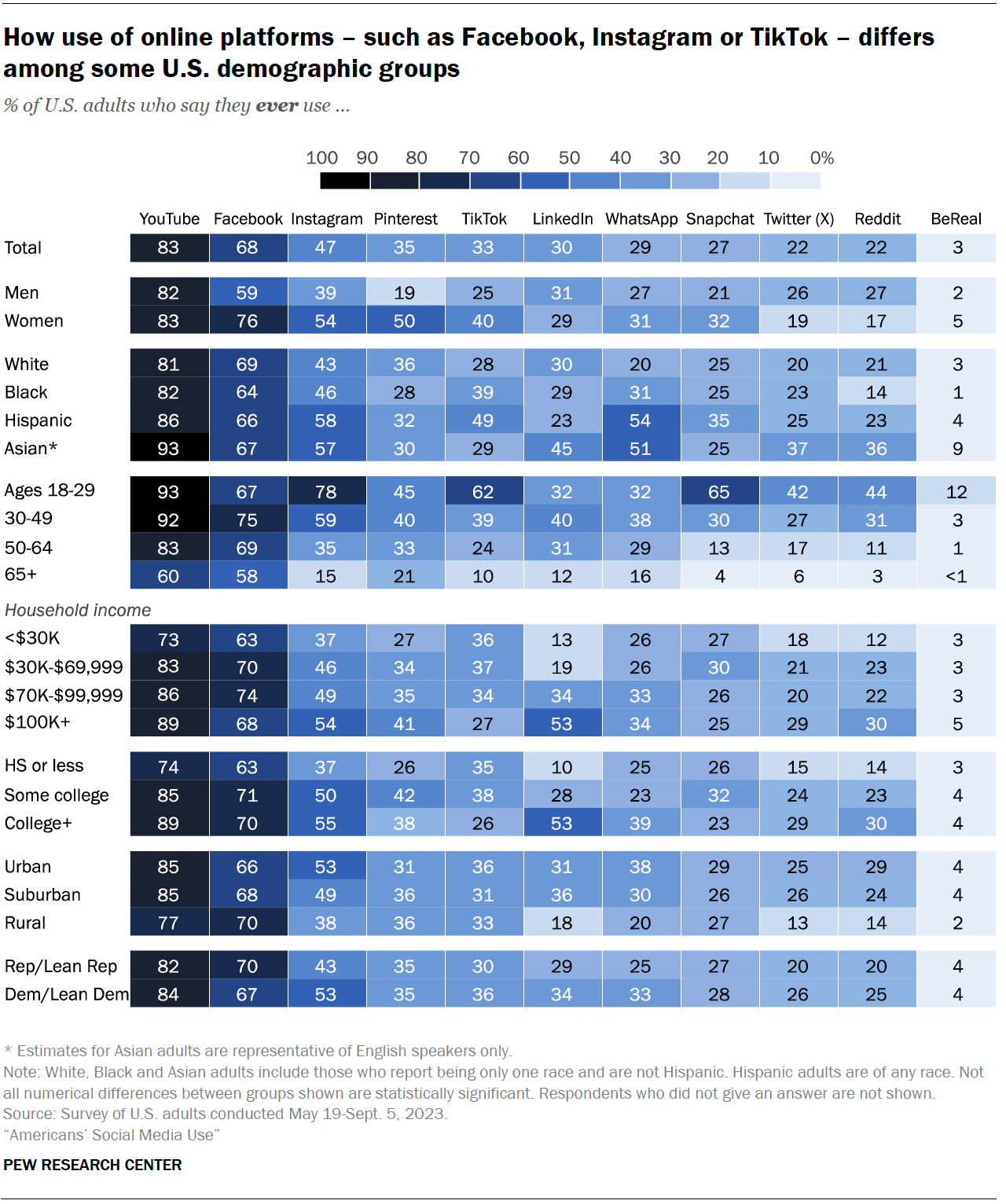How Americans Use Social Media Pew Research Center

YouTube and Facebook are by far the most used online platforms among U.S. adults. But TikTok’s user base has grown significantly in recent years: 33% of U.S. adults now say they use it.
YouTube and Facebook are by far the most used online platforms among U.S. adults; TikTok’s user base has grown since 2021
ByJeffrey Gottfried
Table of Contents
Table of Contents
Americans’ Social Media Use
Which social media sites do Americans use most?
TikTok sees growth since 2021
Stark age differences in who uses each app or site
Other demographic differences in use of online platforms
Acknowledgments
2023 National Public Opinion Reference Survey (NPORS) Methodology
YouTube and Facebook are by far the most used online platforms among U.S. adults; TikTok’s user base has grown since 2021
How we did thisTo better understand Americans’ social media use, Pew Research Center surveyed 5,733 U.S. adults from May 19 to Sept. 5, 2023. Ipsos conducted this National Public Opinion Reference Survey (NPORS) for the Center using address-based sampling and a multimode protocol that included both web and mail. This way nearly all U.S. adults have a chance of selection. The survey is weighted to be representative of the U.S. adult population by gender, race and ethnicity, education and other categories.
Polls from 2000 to 2021 were conducted via phone. For more on this mode shift, read our Q&A.
Here are the questions used for this analysis, along with responses, and its methodology.
A note on terminology: Our May-September 2023 survey was already in the field when Twitter changed its name to “X.” The terms Twitter and X are both used in this report to refer to the same platform.
Social media platforms faced a range of controversies in recent years, including concerns over misinformation and data privacy. Even so, U.S. adults use a wide range of sites and apps, especially YouTube and Facebook. And TikTok – which some Congress members previously called to ban – saw growth in its user base.
These findings come from a Pew Research Center survey of 5,733 U.S. adults conducted May 19-Sept. 5, 2023.
Which social media sites do Americans use most?
 YouTube by and large is the most widely used online platform measured in our survey. Roughly eight-in-ten U.S. adults (83%) report ever using the video-based platform.
YouTube by and large is the most widely used online platform measured in our survey. Roughly eight-in-ten U.S. adults (83%) report ever using the video-based platform.
While a somewhat lower share reports using it, Facebook is also a dominant player in the online landscape. Most Americans (68%) report using the social media platform.
Additionally, roughly half of U.S. adults (47%) say they use Instagram.
The other sites and apps asked about are not as widely used, but a fair portion of Americans still use them:
- 27% to 35% of U.S. adults use Pinterest, TikTok, LinkedIn, WhatsApp and Snapchat.
- About one-in-five say they use Twitter (recently renamed “X”) and Reddit.
This year is the first time we asked about BeReal, a photo-based platform launched in 2020. Just 3% of U.S. adults report using it.
Recent Center findings show that YouTube also dominates the social media landscape among U.S. teens.
TikTok sees growth since 2021
One platform – TikTok – stands out for growth of its user base. A third of U.S. adults (33%) say they use the video-based platform, up 12 percentage points from 2021 (21%).
 The other sites asked about had more modest or no growth over the past couple of years. For instance, while YouTube and Facebook dominate the social media landscape, the shares of adults who use these platforms has remained stable since 2021.
The other sites asked about had more modest or no growth over the past couple of years. For instance, while YouTube and Facebook dominate the social media landscape, the shares of adults who use these platforms has remained stable since 2021.
The Center has been tracking use of online platforms for many years. Recently, we shifted from gathering responses via telephone to the web and mail. Mode changes can affect study results in a number of ways, therefore we have to take a cautious approach when examining how things have – or have not – changed since our last study on these topics in 2021. For more details on this shift, please read our Q&A.
Stark age differences in who uses each app or site
Adults under 30 are far more likely than their older counterparts to use many of the online platforms. These findings are consistent with previous Center data.
 Age gaps are especially large for Instagram, Snapchat and TikTok – platforms that are used by majorities of adults under 30. For example:
Age gaps are especially large for Instagram, Snapchat and TikTok – platforms that are used by majorities of adults under 30. For example:
- 78% of 18- to 29-year-olds say they use Instagram, far higher than the share among those 65 and older (15%).
- 65% of U.S. adults under 30 report using Snapchat, compared with just 4% of the oldest age cohort.
- 62% of 18- to 29-year-olds say they use TikTok, much higher than the share among adults ages 65 years and older (10%).
- Americans ages 30 to 49 and 50 to 64 fall somewhere in between for all three platforms.
YouTube and Facebook are the only two platforms that majorities of all age groups use. That said, there is still a large age gap between the youngest and oldest adults when it comes to use of YouTube. The age gap for Facebook, though, is much smaller.
Americans ages 30 to 49 stand out for using three of the platforms – LinkedIn, WhatsApp and Facebook – at higher rates. For instance, 40% of this age group uses LinkedIn, higher than the roughly three-in-ten among those ages 18 to 29 and 50 to 64. And just 12% of those 65 and older say the same.
Overall, a large majority of the youngest adults use multiple sites and apps. About three-quarters of adults under 30 (74%) use at least five of the platforms asked about. This is far higher than the shares of those ages 30 to 49 (53%), 50 to 64 (30%), and ages 65 and older (8%) who say the same.
Refer to our social media fact sheet for more detailed data by age for each site and app.
Other demographic differences in use of online platforms
A number of demographic differences emerge in who uses each platform. Some of these include the following:
- Race and ethnicity: Roughly six-in-ten Hispanic (58%) and Asian (57%) adults report using Instagram, somewhat higher than the shares among Black (46%) and White (43%) adults.1
- Gender: Women are more likely than their male counterparts to say they use the platform.
- Education: Those with some college education and those with a college degree report using it at somewhat higher rates than those who have a high school degree or less education.
TikTok
- Race and ethnicity: Hispanic adults are particularly likely to use TikTok, with 49% saying they use it, higher than Black adults (39%). Even smaller shares of Asian (29%) and White (28%) adults say the same.
- Gender: Women use the platform at higher rates than men (40% vs. 25%).
- Education: Americans with higher levels of formal education are especially likely to use LinkedIn. For instance, 53% of Americans with at least a bachelor’s degree report using the platform, far higher than among those who have some college education (28%) and those who have a high school degree or less education (10%). This is the largest educational difference measured across any of the platforms asked about.
Twitter (renamed “X”)
- Household income: Adults with higher household incomes use Twitter at somewhat higher rates. For instance, 29% of U.S. adults who have an annual household income of at least $100,000 say they use the platform. This compares with one-in-five among those with annual household incomes of $70,000 to $99,999, and around one-in-five among those with annual incomes of less than $30,000 and those between $30,000 and $69,999.
- Gender: Women are far more likely to use Pinterest than men (50% vs. 19%).
- Race and ethnicity: 54% of Hispanic adults and 51% of Asian adults report using WhatsApp. This compares with 31% of Black adults and even smaller shares of those who are White (20%).
 How we did thisTo better understand Americans’ social media use, Pew Research Center surveyed 5,733 U.S. adults from May 19 to Sept. 5, 2023. Ipsos conducted this National Public Opinion Reference Survey (NPORS) for the Center using address-based sampling and a multimode protocol that included both web and mail. This way nearly all U.S. adults have a chance of selection. The survey is weighted to be representative of the U.S. adult population by gender, race and ethnicity, education and other categories.
How we did thisTo better understand Americans’ social media use, Pew Research Center surveyed 5,733 U.S. adults from May 19 to Sept. 5, 2023. Ipsos conducted this National Public Opinion Reference Survey (NPORS) for the Center using address-based sampling and a multimode protocol that included both web and mail. This way nearly all U.S. adults have a chance of selection. The survey is weighted to be representative of the U.S. adult population by gender, race and ethnicity, education and other categories.
Polls from 2000 to 2021 were conducted via phone. For more on this mode shift, read our Q&A.
Here are the questions used for this analysis, along with responses, and its methodology.
A note on terminology: Our May-September 2023 survey was already in the field when Twitter changed its name to “X.” The terms Twitter and X are both used in this report to refer to the same platform.
Social media platforms faced a range of controversies in recent years, including concerns over misinformation and data privacy. Even so, U.S. adults use a wide range of sites and apps, especially YouTube and Facebook. And TikTok – which some Congress members previously called to ban – saw growth in its user base.
These findings come from a Pew Research Center survey of 5,733 U.S. adults conducted May 19-Sept. 5, 2023.
Which social media sites do Americans use most?
 YouTube by and large is the most widely used online platform measured in our survey. Roughly eight-in-ten U.S. adults (83%) report ever using the video-based platform.
YouTube by and large is the most widely used online platform measured in our survey. Roughly eight-in-ten U.S. adults (83%) report ever using the video-based platform.
While a somewhat lower share reports using it, Facebook is also a dominant player in the online landscape. Most Americans (68%) report using the social media platform.
Additionally, roughly half of U.S. adults (47%) say they use Instagram.
The other sites and apps asked about are not as widely used, but a fair portion of Americans still use them:
- 27% to 35% of U.S. adults use Pinterest, TikTok, LinkedIn, WhatsApp and Snapchat.
- About one-in-five say they use Twitter (recently renamed “X”) and Reddit.
This year is the first time we asked about BeReal, a photo-based platform launched in 2020. Just 3% of U.S. adults report using it.
Recent Center findings show that YouTube also dominates the social media landscape among U.S. teens.
TikTok sees growth since 2021
One platform – TikTok – stands out for growth of its user base. A third of U.S. adults (33%) say they use the video-based platform, up 12 percentage points from 2021 (21%).
 The other sites asked about had more modest or no growth over the past couple of years. For instance, while YouTube and Facebook dominate the social media landscape, the shares of adults who use these platforms has remained stable since 2021.
The other sites asked about had more modest or no growth over the past couple of years. For instance, while YouTube and Facebook dominate the social media landscape, the shares of adults who use these platforms has remained stable since 2021.
The Center has been tracking use of online platforms for many years. Recently, we shifted from gathering responses via telephone to the web and mail. Mode changes can affect study results in a number of ways, therefore we have to take a cautious approach when examining how things have – or have not – changed since our last study on these topics in 2021. For more details on this shift, please read our Q&A.
Stark age differences in who uses each app or site
Adults under 30 are far more likely than their older counterparts to use many of the online platforms. These findings are consistent with previous Center data.
 Age gaps are especially large for Instagram, Snapchat and TikTok – platforms that are used by majorities of adults under 30. For example:
Age gaps are especially large for Instagram, Snapchat and TikTok – platforms that are used by majorities of adults under 30. For example:
- 78% of 18- to 29-year-olds say they use Instagram, far higher than the share among those 65 and older (15%).
- 65% of U.S. adults under 30 report using Snapchat, compared with just 4% of the oldest age cohort.
- 62% of 18- to 29-year-olds say they use TikTok, much higher than the share among adults ages 65 years and older (10%).
- Americans ages 30 to 49 and 50 to 64 fall somewhere in between for all three platforms.
YouTube and Facebook are the only two platforms that majorities of all age groups use. That said, there is still a large age gap between the youngest and oldest adults when it comes to use of YouTube. The age gap for Facebook, though, is much smaller.
Americans ages 30 to 49 stand out for using three of the platforms – LinkedIn, WhatsApp and Facebook – at higher rates. For instance, 40% of this age group uses LinkedIn, higher than the roughly three-in-ten among those ages 18 to 29 and 50 to 64. And just 12% of those 65 and older say the same.
Overall, a large majority of the youngest adults use multiple sites and apps. About three-quarters of adults under 30 (74%) use at least five of the platforms asked about. This is far higher than the shares of those ages 30 to 49 (53%), 50 to 64 (30%), and ages 65 and older (8%) who say the same.
Refer to our social media fact sheet for more detailed data by age for each site and app.
Other demographic differences in use of online platforms
A number of demographic differences emerge in who uses each platform. Some of these include the following:
- Race and ethnicity: Roughly six-in-ten Hispanic (58%) and Asian (57%) adults report using Instagram, somewhat higher than the shares among Black (46%) and White (43%) adults.1
- Gender: Women are more likely than their male counterparts to say they use the platform.
- Education: Those with some college education and those with a college degree report using it at somewhat higher rates than those who have a high school degree or less education.
TikTok
- Race and ethnicity: Hispanic adults are particularly likely to use TikTok, with 49% saying they use it, higher than Black adults (39%). Even smaller shares of Asian (29%) and White (28%) adults say the same.
- Gender: Women use the platform at higher rates than men (40% vs. 25%).
- Education: Americans with higher levels of formal education are especially likely to use LinkedIn. For instance, 53% of Americans with at least a bachelor’s degree report using the platform, far higher than among those who have some college education (28%) and those who have a high school degree or less education (10%). This is the largest educational difference measured across any of the platforms asked about.
Twitter (renamed “X”)
- Household income: Adults with higher household incomes use Twitter at somewhat higher rates. For instance, 29% of U.S. adults who have an annual household income of at least $100,000 say they use the platform. This compares with one-in-five among those with annual household incomes of $70,000 to $99,999, and around one-in-five among those with annual incomes of less than $30,000 and those between $30,000 and $69,999.
- Gender: Women are far more likely to use Pinterest than men (50% vs. 19%).
- Race and ethnicity: 54% of Hispanic adults and 51% of Asian adults report using WhatsApp. This compares with 31% of Black adults and even smaller shares of those who are White (20%).
 Next: Acknowledgments ← Prev Page123Next Page → 103. Estimates for Asian adults are representative of English speakers only.↩
Next: Acknowledgments ← Prev Page123Next Page → 103. Estimates for Asian adults are representative of English speakers only.↩
Sign up for our weekly newsletter
Fresh data delivery Saturday mornings
Sign Up Fresh data delivery Saturday mornings
Sign up for The Briefing
Weekly updates on the world of news & information
Sign Up Weekly updates on the world of news & information
Topics
- Internet & Technology
- Social Media
- TikTok
- Twitter (X)
- YouTube
Share This Link:- X
- Threads
- WhatsApp Share
Related
short readsSep 17, 2024
More Americans – especially young adults – are regularly getting news on TikTok
short readsAug 26, 2024
Many Israelis say social media content about the Israel-Hamas war should be censored
short readsMar 22, 2024
WhatsApp and Facebook dominate the social media landscape in middle-income nations
short readsMar 6, 2024
Germans stand out for their comparatively light use of social media
short readsFeb 23, 2024
Majorities in most countries surveyed say social media is good for democracy
short readsSep 17, 2024
More Americans – especially young adults – are regularly getting news on TikTok
short readsAug 26, 2024
Many Israelis say social media content about the Israel-Hamas war should be censored
short readsMar 22, 2024
WhatsApp and Facebook dominate the social media landscape in middle-income nations
short readsMar 6, 2024
Germans stand out for their comparatively light use of social media
short readsFeb 23, 2024
Majorities in most countries surveyed say social media is good for democracy
Most Popular
1In Tied Presidential Race, Harris and Trump Have Contrasting Strengths, Weaknesses2Are you in the American middle class? Find out with our income calculator3Latinx Awareness Has Doubled Among U.S. Hispanics Since 2019, but Only 4% Use It4Key things to know about U.S. election polling in 20245What we know about unauthorized immigrants living in the U.S. 1In Tied Presidential Race, Harris and Trump Have Contrasting Strengths, Weaknesses2Are you in the American middle class? Find out with our income calculator3Latinx Awareness Has Doubled Among U.S. Hispanics Since 2019, but Only 4% Use It4Key things to know about U.S. election polling in 20245What we know about unauthorized immigrants living in the U.S.
FAQ
How far can you shoot 12 gauge buckshot?
Remington Bankruptcy in 2018 Remington’s paused production led to customers getting their ammo from other brands. Other ammo manufacturers gladly took Remington’s customers, but they struggled to cope with the sudden demand increase, contributing to the ammunition shortage.Mar 15, 2022
バックショットルーレットのクリア時間は?
白熱のゲームプレイ ゲーム所要時間は15分から20分。 アリーナに入り、ディーラーと3ラウンド戦い、賞金を手にして退出しよう… ただし、負けたら出
How to see Downloads in Google Android?
Go to the site where you want to download a file. Touch and hold what you want to download, then tap Download link or Download image. On some video and audio files, tap Download .
Can you get Buckshot Roulette for free?
Buckshot Roulette - Play Game For Free - Play Buckshot Roulette - Play Game For Free On Rankdle.
Is Buckshot Roulette free on PS5?
Nope, Buckshot Roulette isn’t on the PS5.
Buckshot Roulette free online platform, Give you more than free download, what is buckshot roulette and how to play.
This site only collects related articles. Viewing the original, please copy and open the following link:How Americans Use Social Media Pew Research Center

















































































































































































